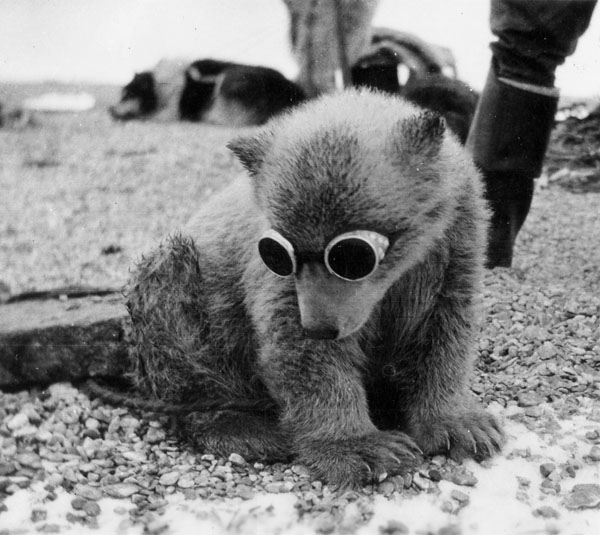|
Goggles
Goggles, or safety glasses, are forms of protective eyewear that usually enclose or protect the area surrounding the eye in order to prevent particulates, water or chemicals from striking the eyes. They are used in chemistry laboratories and in woodworking. They are often used in snow sports as well, and in swimming. Goggles are often worn when using power tools such as drills or chainsaws to prevent flying particles from damaging the eyes. Many types of goggles are available as prescription goggles for those with vision problems. History The Inuit and Yupik peoples carved snow goggles from the antlers of caribou, wood, and shell to help prevent snow blindness. The goggles were curved to fit the user's face and had a large groove cut in the back to allow for the nose. A long thin slit was cut through the goggles to allow in a small amount of light, diminishing subsequent ultraviolet rays. The goggles were held to the head by a cord made of caribou sinew. In the ... [...More Info...] [...Related Items...] OR: [Wikipedia] [Google] [Baidu] |
Snow Goggles
Snow goggles (Inuktitut: or , syllabics: or ; esu, nigaugek, ) are a type of eyewear traditionally used by the Inuit and the Yupik peoples of the Arctic to prevent snow blindness. The goggles fit tightly against the face so that the only light entering is through the slits, and soot is sometimes applied to the inside to help cut down on glare. The slits are made narrow not only to reduce the amount of light entering but also to improve the visual acuity. Wider slits result in a larger field of view. Terminology Like other Inuit language words, such as inukhuk/inuksuk, a different word may be used in different dialects. In the Kivalliq dialect, () is used, while the North Baffin dialect uses (). Both words are also used to refer to sunglasses. In Central Yup'ik, snow goggles are called , while in Cup'ig they are ''igguag''. In Siberian Yupik Siberian Yupiks, or Yuits (russian: Юиты), are a Yupik peoples, Yupik people who reside along the coast of the Ch ... [...More Info...] [...Related Items...] OR: [Wikipedia] [Google] [Baidu] |
Eye Protection
Eye protection is protective gear for the eyes, and sometimes face, designed to reduce the risk of injury. Examples of risks requiring eye protection can include: impact from particles or debris, light or radiation, wind blast, heat, sea spray or impact from some type of ball or puck used in sports. Eye protection are typically separated into categories based on the style of eye wear and the hazard they are designed to reduce. There categories include: Spectacles with side protection; Goggles; Welding helmet; Welding Hand Shields; Non-Rigid Helmets (hoods); Face shield; and Respirator Face pieces. Styles Spectacles Safety glasses or spectacles, although often used as a catch-all term for all types of eye protection, specifically revers to protective equipment that closely resembles common eye wear. To meet most national standards, spectacles must include side shields to reduce the ability of debris to get behind the lenses from the side. Safety glasses can often mo ... [...More Info...] [...Related Items...] OR: [Wikipedia] [Google] [Baidu] |
Photokeratitis
Photokeratitis or ultraviolet keratitis is a painful eye condition caused by exposure of insufficiently protected eyes to the ultraviolet (UV) rays from either natural (e.g. intense sunlight) or artificial (e.g. the electric arc during welding) sources. Photokeratitis is akin to a sunburn of the cornea and conjunctiva. The injury may be prevented by wearing eye protection that blocks most of the ultraviolet radiation, such as welding goggles with the proper filters, a welder's helmet, sunglasses rated for sufficient UV protection, or appropriate snow goggles. The condition is usually managed by removal from the source of ultraviolet radiation, covering the corneas, and administration of pain relief. Photokeratitis is known by a number of different terms including: snow blindness, arc eye, welder's flash, bake eyes, corneal flash burns, flash burns, niphablepsia, or keratoconjunctivitis photoelectrica. Signs and symptoms Common symptoms include pain, intense tears, eyelid tw ... [...More Info...] [...Related Items...] OR: [Wikipedia] [Google] [Baidu] |
Snow Blindness
Photokeratitis or ultraviolet keratitis is a painful eye condition caused by exposure of insufficiently protected eyes to the ultraviolet (UV) rays from either natural (e.g. intense sunlight) or artificial (e.g. the electric arc during welding) sources. Photokeratitis is akin to a sunburn of the cornea and conjunctiva. The injury may be prevented by wearing eye protection that blocks most of the ultraviolet radiation, such as welding goggles with the proper filters, a welder's helmet, sunglasses rated for sufficient UV protection, or appropriate snow goggles. The condition is usually managed by removal from the source of ultraviolet radiation, covering the corneas, and administration of pain relief. Photokeratitis is known by a number of different terms including: snow blindness, arc eye, welder's flash, bake eyes, corneal flash burns, flash burns, niphablepsia, or keratoconjunctivitis photoelectrica. Signs and symptoms Common symptoms include pain, intense tears, ey ... [...More Info...] [...Related Items...] OR: [Wikipedia] [Google] [Baidu] |



